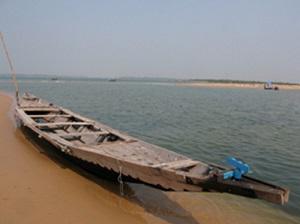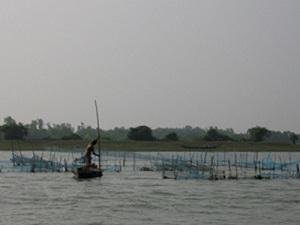Coralie D' Lima
This project aims to analyse the impact of human-related mortality on the population dynamics and viability of the Irrawaddy dolphin, Orcaella brevirostris at Chilika lagoon, Orissa, India.

The banks of the lagoon.
Chilika lagoon, located on the east coast of India, is a Ramsar site and an important biodiversity hotspot in Asia. Apart from supporting a large number of bird species, it is also rich in several species of harvested fish and serves as a means of livelihood to many fishermen. The lagoon is also home to the Irrawaddy dolphin, Orcaella brevisrostris. This population of dolphins is geographically isolated, and therefore possibly severely threatened.

Fishing at Chilika.
While recent population estimates range from 85 to 130 individuals (using both direct counts and photo-ID techniques), mortality data from 2002 to 2006 indicate an average of around 8 deaths per year. The main causes of mortality during this time period were found to be entanglement in fishing gear and collisions with mechanized boats, reflecting prevailing conflicts with the local fishing community and tourist boat operators. Although management authorities have taken enforcement measures to control gill netting and collision related mortality, the efficacy of these management strategies has not yet been quantified.
The study herein will therefore focus on key aspects regarding the demography and population dynamics of the Irrawaddy dolphin at Chilika lagoon to allow for an assessment of the effectiveness of currently used management strategies. This project will commence in January 2008.
The short-term objectives of this project are:
/ to continue photo-identification of individuals in order to refine population estimates
/ to study trends in dolphin population dynamics, to analyse the resource utilization of dolphins and man
/ the quantification of human induced threats to dolphins
/ to conduct workshops (based on scientific knowledge) in order to educate local people, and enable/facilitate them to participate in dolphin conservation.
The long-term objectives of this project include:
/ a projection of the dolphin population with the help of a simulation model
/ a careful analysis of the efficacy of currently used management strategies (as well as potential alternative management scenarios)
/ an expansion of the current management plan to include alternative management scenarios (as tested above), in consultation with government, scientific, local and international stakeholders and the implementation of a revised management plan with the help of all stakeholders.